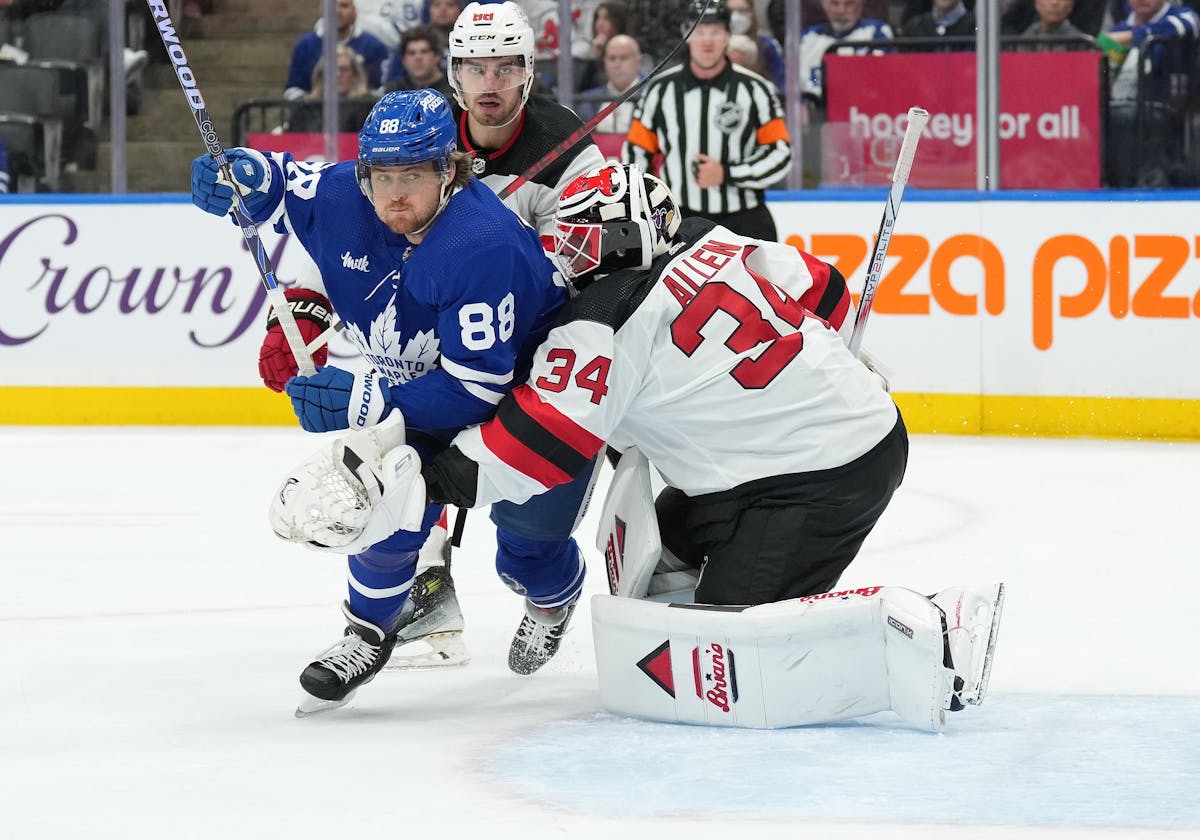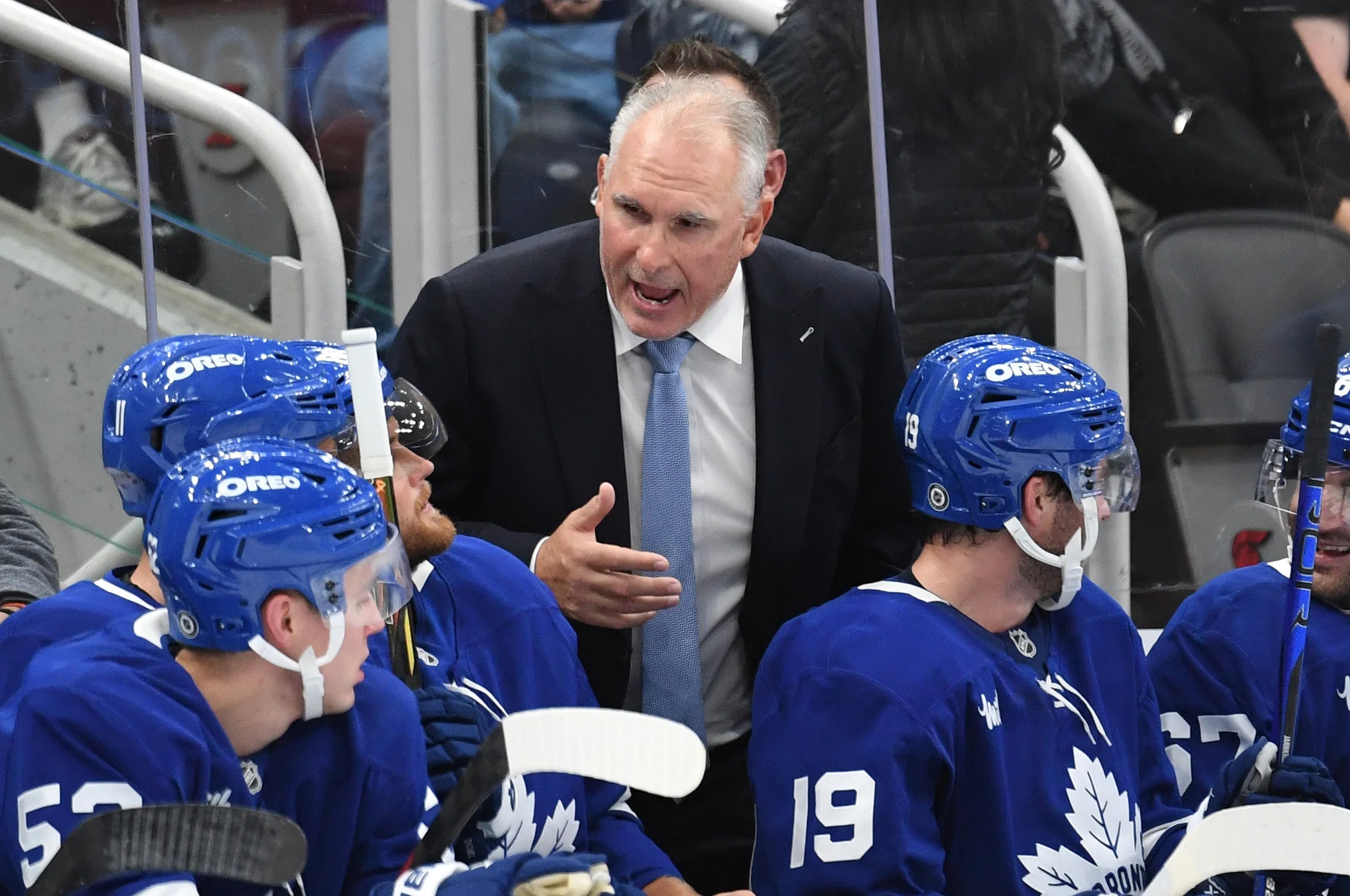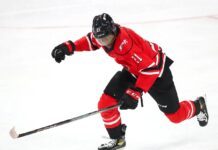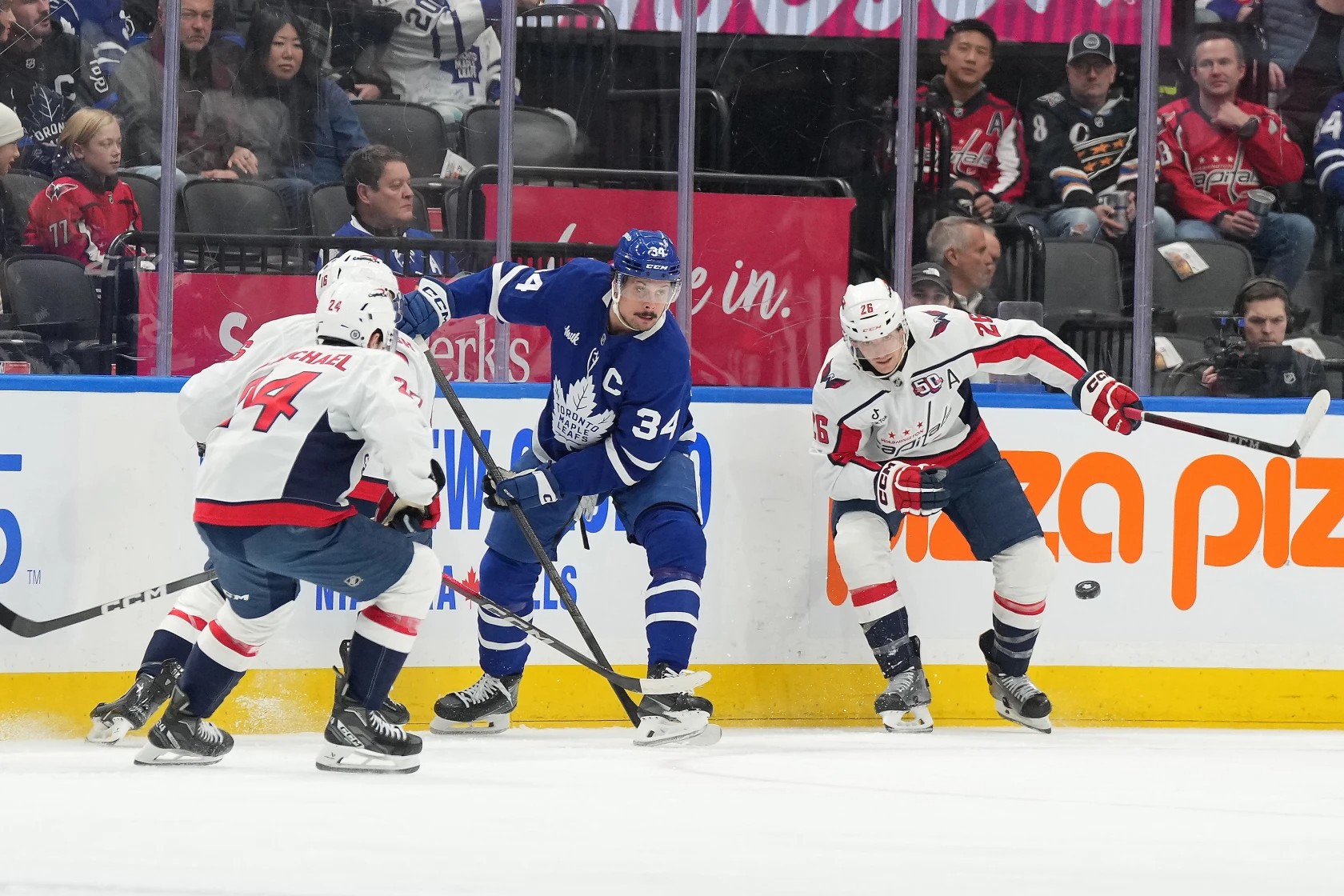As each season unfolds, we try to track the Maple Leafs’ day-to-day results with an eye toward the big-picture trends in this space.
Early this season, the Leafs clamped it down defensively, benefitting from a new system and improved personnel on the blue line (We previously discussed their extremely impressive defensive numbers as a team). Before Auston Matthews fell injured, they were also trending as a top-10 possession team. They were suffocating defensively and spent much of the game in the offensive zone. Their start could have been something special with even a mediocre power play, but the overall play was impressive.
Then, Auston Matthews got injured just as the power play heated up, masking a big dip in their control over the five-on-five play. From the time of Matthews’s injury through the rest of November, the Leafs were the second-worst possession team in the league. Only the Chicago Blackhawks, who just fired their head coach and are a complete mess, were worse. The Leafs owned just 44 percent of the shot attempts in a month of hockey. That mark is in line with Chicago, San Jose, and Anaheim of the last few seasons, and two of those teams landed the first overall draft pick.
Now, the Leafs weren’t just without Matthews; they were missing half the forward group and were clearly in survival mode. They managed to minimize scoring chances as much as possible in that time, basically netting even in expected goals and winning their five-on-five minutes 13-9 overall (while receiving a slight boost in the goal column when Matthews returned at the end of the month; they scored just nine five-on-five goals without their captain).
The Leafs‘ power play and remaining star players carried the mail, leading them to a great record, but it wasn’t sustainable over the long term if the goal is to win and succeed in the playoffs.
Since Matthews returned, the numbers haven’t exactly improved, either. The Leafs are controlling less than 44 percent of the shot attempts at five-on-five and 40 percent of expected goals over Matthews’ last five games, but they have won the minutes 11-7 in goals in part by scoring against bottom dwellers they won’t face in the playoffs.
The win-loss results are almost secondary. The Leafs are good defensively and talented enough to be in most games one way or another. They just lost back-to-back games where Washington was pumping up their own performance as a “great road win,” while Pittsburgh’s Mike Sullivan declared, “It might’ve been the most complete game that we’ve played all year from start to finish.” And yet the Leafs had opportunities late in both games to tie it, and I don’t think they played particularly well in either game. It speaks to their talent level and ability to prevent goals that they can hang around in games when they have their B or C game, but the run of play was most concerning.
As the Leafs play deeper teams like Washington, missing several key regular forwards has clearly started to add up. Running essentially two lines capable of providing any offense or positive momentum stresses the defense, which is saddled with sharing the ice with the bottom lines throughout the game. It starts their top lines behind the eight ball, creating a bit of a snowball effect.
All of that said, the Leafs are about to get healthy. Jake McCabe, Bobby McMann, and Max Domi are all expected to return shortly. David Kampf isn’t eligible to return until December 14, and it’s unclear if he’ll be ready by then, although he has been skating. Those forwards upgrade the current personnel, but they also need to right the ship with the process within their game.
It hasn’t helped that the Leafs have shuffled an inordinate number of players in and out of the lineup, but they are getting tilted on the ice at the level of a lottery team. Washington controlled the entirety of their game against the Leafs, and Pittsburgh went into a tied third period and outplayed the Leafs, leading to the Penguins retaking the lead they earned earlier on. Earlier in the week, the Leafs were completely outplayed against Chicago on home ice (a 28-7 shot attempt difference in the second period and just five shot attempts in the third period for the Leafs –– against Chicago).
This is a good Leafs team; everyone knows it—including the team itself—but as they return closer to full health, they must demonstrate that the dip in five-on-five play was simply due to injuries. They have been unable to consistently break out cleanly, hindering them all the way up the ice (can’t generate speed through the neutral zone, can’t get in on the forecheck properly as a result, can’t keep the puck in the offensive zone, etc.).
If the aim is to grind teams down—which it is when playing more of a dump-and-chase game—the Leafs need to spend time in the offensive zone to accomplish this goal. They need to tilt the ice in their favour. They can’t only rely on goaltending supported by good special teams.
As we enter this busy stretch of December games and the team returns to full strength (or close to it), this is the number one item to track this month. They showed us flashes early on, but the injuries derailed the process underway. Those excuses are now losing their validity, though, and the Leafs need to get their overall game trending in the right direction.
Notes

– In the last three games, the Leafs have been scored on first amidst some really tough starts to their games. Their first few shifts have generally been weak and set the tone for the period/game.
With the Leafs ‘excellent goaltending and improved defense, they are a really tough team to beat when they hold the lead. They are third in the league in win percentage this season when scoring first. It makes sense, considering they are strong defensively and in net, and they have the talent to burn the opposition if they cheat to get back into the game.
However, when is the last game you could fairly argue the Leafs came out guns blazing? Only a few really stand out: both games against Tampa, their game in Winnipeg, the start against the LA Kings in game four of the season, and a disallowed goal against Detroit not even two minutes in (they later scored first on a power play).
It would be nice to see some consistently hungrier starts from this team. They are a tough out when they score first. Last season, they were 21st in this category, as they were too leaky defensively and in net to feel confident in any lead.
– The Leafs have only lost once when scoring first. It’s the best mark in the league, tied with Vegas. They have a perfect record when leading after two periods. They are showing us they can play with a lead and lock games down. It’s time for more urgency at the start of games to earn those leads. The Leafs are 23rd in the league in first-period goals; it’s the second period where they do most of their damage.
– The Leafs are middle-of-the-pack in terms of winning when getting scored on first, but for all the talk about lack of offense, I was pleasantly surprised to see they are actually fifth in the league in winning percentage when trailing after two periods — even more surprising knowing they’ve scored the fourth-fewest goals in the league in the third period.
– William Nylander’s ice time was a bit of a story early on this season, especially after he discussed it with the media and Craig Berube addressed it around the same time. To increase his ice time, the coaching staff has been keeping Nylander on the ice for the full two minutes of power plays, even after the top unit changes.
The kicker is that it hasn’t produced anything, and he often looks tired and lethargic in the final 30 seconds of a power play when he’s on with the second unit. Nylander’s game is centered around his high-end skating and ability to drive to the net with his underrated strength. He’s not exactly Alex Ovechkin standing in one spot while getting fed one-timers. The “second” unit power play has yet to score, and its only real purpose is to artificially inflate his minutes.
– The goal Washington scored where Nick Robertson and Fraser Minten miscommunicated return to the Leafs’ end, resulting in Robertson not properly sealing the wall, was the first time Steven Lorentz has been on for a five-on-five goal against since October 22nd against Columbus — and obviously, he had nothing to do with this goal.
Lorentz has moved up and down between the fourth and third lines and has been a reliable player. He won’t produce much, but he’s also not giving up much defensively. A player who can be trusted to be sound defensively and throw his weight around is valuable in and of itself.
Alongside Connor Dewar, who has been solid defensively at center, it’s a good base for a defensive fourth line. The question is whether those two, along with whoever the third forward is, can do anything up the ice to be more than a “nothing bad happens when we’re on” fourth line. Dewar has yet to record a point this season through 11 games.
– I know that it’s largely due to injury, but 27 games into the season, I did not expect Chris Tanev to have more points than all but five of the Leafs’ forwards (the regular four + Knies). He’s underrated when it comes to moving the puck, and simply breaking out cleanly will earn him points, along with the odd game like the one against Tampa (a great pass to Tavares down the ice).
It also speaks to the Leafs’ lack of depth scoring in general. It’ll improve as they return to full health, but this was a golden opportunity for players down the lineup to prove that they deserve more. Other than maybe Fraser Minten, who has really elevated their outlook with these increased minutes? Pontus Holmberg is a coach’s favourite, but he hasn’t produced. Nick Robertson hasn’t produced and was healthy scratched in Pittsburgh. We could go on and on here. Opportunity was there for the taking, but nobody really grabbed hold of it.
Quotes

“In my type of game, I can’t really manage my body. Like, I’m going hard every single shift. So, just playing with the tiredness, I guess.”
– Simon Benoit on managing his body when the Leafs play on back-to-back nights
You have to respect that Simon Benoit completely understands who he is and what he has to do in order to play in the NHL. There are no shortcuts.
Since coming back from a healthy scratch, Benoit is playing much better hockey. Before the scratch, he was averaging just 15:51 per game. Since he re-entered the lineup, Benoit is playing 18:03 per night. It’s partly due to the McCabe injury, but he has played well to earn more ice time, and it’s almost all coming at even strength (rather than simply replacing McCabe’s penalty-killing minutes).
Despite starting just 33.78 percent of his shifts in the offensive zone, Benoit has been on for seven goals against and nine goals for. He also has a modest five shots in those six games, which isn’t much (he has just one assist in that span), but it’s a notable uptick from the previous 17 games (10 shots). He is pushing himself to be more involved offensively, and he’s had a few moments in alone (including most recently hitting the post against Pittsburgh). He has to start somewhere, and there are some minor signs of growth.
“When I watch, whether it is JT with Mitch, JT with Willy… To me, that is all just the ebbs and flows of a season. In my time here, it happened. Guys get moved around. It gets stale. You move it, and then it goes back.
They are just very, very elite players. When Mitch and Auston are playing together or Johnny and Willy, there is chemistry because they have played together for a long time. They can make a ton of plays in the offensive zone and off the rush. You have to be ready.
In my time here, I always appreciated that [Sheldon Keefe] would do a pretty good job of getting Willy, Auston, and Mitch on the ice at the same time three or four times a game. That wasn’t any genius plan that Keefer had. You have three really good players, so get them out on the ice. You can look like a really good coach doing that.
We also have to know that in the third period (last game), they had a huge period together, so that chemistry is going to be back, and they are feeling really good about themselves going into tonight.”
– Spencer Carbery on the Leafs’ top players
Just as Craig Berube was quick to reunite Matthews and Marner, it needs to be treated the same way on the flip side. He can’t hesitate to split them up when they aren’t up to much of anything.
“On that play, the bottom line is that instead of just going the other way with the puck, we brought it back. We did that too much tonight, from the first period on. It was the whole game. It eventually bit us and cost us.
We didn’t play a north game. We didn’t play fast. They were the better team. They deserved to win.”
– Craig Berube on the loss to Washington
Berube has been consistently harping on “playing north.” When I went back to watch the Capitals’ 2-1 goal a few times, I could see why.
It started with a chip into the zone where Morgan Rielly cut across to get it. He could have gone right up to the short side to his defense partner on the play (Conor Timmins), but he instinctively brought it back and rimmed it to the far side. Waiting on the wall was Mitch Marner, who instinctively tried to bring it back instead of immediately bumping it to Auston Matthews in the slot or up the wall and out. When Matthews went to help out, he was jammed up and again tried to bring it back around the net rather than right up to Marner, who was relatively open.
On this play, the Leafs were burned for a goal against, but over the course of the game, they are robbing themselves of opportunities to move up ice with speed. We have talked about this during/after the playoffs a million times. Regroups allow the opposition to set up their neutral zone structure defensively, and playoff teams are too good to allow them to do this. You have to move up ice immediately and create breakdowns.
Tweets of the Week

Team Goal Share on Special Teams – December 8 pic.twitter.com/hzCZ8uhzsU
— JFresh (@JFreshHockey) December 8, 2024
The Leafs’ power play punching well below its weight this season is clearly to blame for netting out negatively on special teams so far, but it’s also worth noting that it’s kind of astonishing their overall record is what it is given this fact. As we saw when their power play recently heated up, they are extremely difficult to beat with a strong man advantage, given how good they’ve been defensively at five-on-five and how strong their goaltending is overall.
That said, the power play needs to start pulling its weight, and the team needs to do a better job of staying out of the box. They have the fifth-worst net penalty differential (drawn vs. taken) per 60 minutes in the NHL.
Setting the Tone
The Leaf: Blueprint Moment presented by @Rogers pic.twitter.com/5uojzdtoSo
— Toronto Maple Leafs (@MapleLeafs) December 5, 2024
I liked seeing Berube walk into the room and tell the team that they were going to win the game (they were trailing 1-0 at the time). It’s a nice glimpse into the approach he takes and how direct and confident he is with the players.
160 even strength minutes for the Panthers with Forsling and Barkov on the ice together so far this season:
•Shots: 97-52
•High danger chances: 39-12
•Goals: 7-0https://t.co/GVgNGHpViB— Dimitri Filipovic (@DimFilipovic) December 8, 2024
While this tweet is technically about the Florida Panthers, it’s really relevant to the Leafs, knowing this is what they are eventually going to have to overcome. There is a lot of talk about spreading out their top three players across three lines; if they can add another quality forward, I’d like them to do that, too. However, the gold standard of matching up against the Barkov line – Forsling defense pairing combination has to be kept in mind.
With the Leafs’ current personnel, if they spread it out across three lines, it’s not deep enough to make Florida twice. This Panthers unit will steamroll any spread-out combination the Leafs put together. You certainly wouldn’t put out a Tavares line at center to go head-to-head against them, and you aren’t putting Matthews out with Domi on the right wing against them, either.
In many respects, it likely will come down to facing the Panthers, this matchup, and fighting their way through it.
Five Things I Think I’d Do

1. I think it’s the right call to scratch Nikita Grebenkin, and as soon as they have enough healthy NHL bodies — which should be any day now — he should be sent back down to the Marlies.
Grebenkin is a fun player who has created some moments, but he ultimately has zero points in seven games and just two shots on net. He spent a lot of time hemmed in his own end and has really struggled to break out on the wall. He has been outscored 2-0 in his five-on-five minutes and has played under eight minutes in four of those seven games.
Playing limited minutes and producing zero offense isn’t helping the player’s development.
2. When Max Domi and Bobby McMann return, I think I’d like to see them start on the third line, and their linemate should be either Fraser Minten (at center) or Nick Robertson (on right wing). The top six is in place, and the Leafs can freely rotate between Matthew Knies and Max Pacioretty as left wingers on either line.
That would leave a fourth line of Steven Lorentz – Connor Dewar – Pontus Holmberg, with Ryan Reaves rotating in depending on the opponent. They have to start manufacturing some offense in the bottom six, as Berube noted.
3. With Jake McCabe’s imminent return, I think I would like another look at the early season pairings of Morgan Rielly–Chris Tanev and OEL-McCabe. The McCabe-Tanev pairing is undoubtedly their best pairing, but the Rielly-OEL pairing struggles, and the OEL-Tanev pairing couldn’t control 40 percent of the shot attempts together.
At the beginning of the season, both of the pairings I mentioned were humming along. Unless they plan on adding another defenseman down the road, they need to get to two good pairings, not one really good one and one that struggles, supported by a decent third pairing.
I’d also like to look at the old Benoit-McCabe pairing and an OEL-Timmins offensive pairing. They have to continue playing with these combinations; I don’t think they’ve found the properly optimized group of six as things stand. All we really know is that McCabe-Tanev is excellent and Benoit-Timmins is a decent third pairing. Everything else has been subpar, or we haven’t had enough time to evaluate it.
4. I think the five-forward power play looks as expected: dangerous and slotted correctly. They did everything but score against Washington, and they scored a nice goal following a dominant sequence against the Penguins.
I have no real notes beyond keeping it together and giving them time to get truly comfortable and rolling. It takes time to settle in, but the early returns are extremely promising.
5. In case it needs to be said, I think Joseph Woll and Anthony Stolarz should continue alternating unless one of their games completely falls off. Both have been excellent so far, but as we hit the middle portion of the NHL schedule, it will be extremely important to manage both of their workloads and ensure neither is gassed heading into the spring.
The Four Nations break should also help, and that’s the next milestone I’d be eyeing before even thinking about giving one of them the net to run with (again, unless one forces their hand by playing poorly).

































